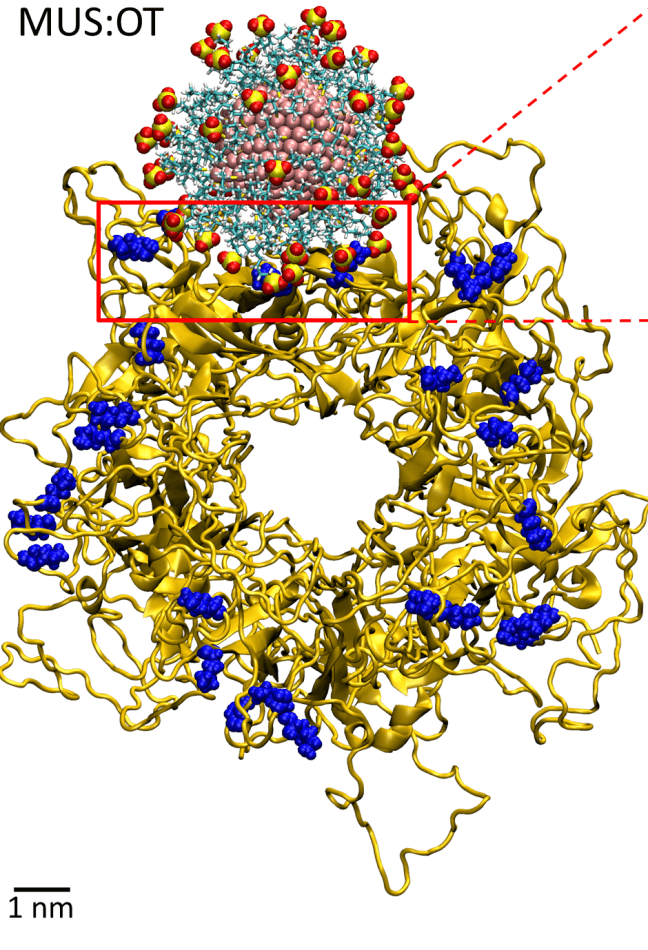Dec 19 2017
Each year, globally, millions of people die due to viral infections. However, antiviral drugs available at present are restricted because they generally function against a few related viruses. Although there are a handful of broad-spectrum drugs with the potential to block the entry of viruses into healthy cells, these generally have to be taken constantly to prevent infection meaning that resistance due to viral mutation is a grave risk.
 A molecular dynamics model showing a nanoparticle binding to the outer envelope of the human papillomavirus. CREDIT: Petr Kral.
A molecular dynamics model showing a nanoparticle binding to the outer envelope of the human papillomavirus. CREDIT: Petr Kral.
At present, an international research team including Petr Kral, a UIC professor of chemistry, has developed innovative anti-viral nanoparticles with the ability to bind to a range of viruses such as respiratory syncytial virus, herpes simplex virus, Dengue and Lentiviruses, and human papillomavirus. In contrast to other broad-spectrum antivirals, which just restrict viruses from infecting cells, the nanoparticles developed by the team have the ability to destroy viruses.
The outcomes of the study have been published in the Nature Materials journal.
The innovative nanoparticles imitate a cell surface protein known as heparin sulfate proteoglycan (HSPG). Majority of the viruses, inclusive of HIV, gain entry into and infect healthy cells by initially binding to HSPGs on the cell surface. Prevalent drugs that imitate HSPG get attached to the virus and restrict it from getting bound to cells. However, the bond’s strength is comparatively weak. Moreover, these drugs do not have the potential to kill viruses, and the viruses might get reactivated upon decreasing the concentration of the drug.
Kral and his team, which comprised assistant professor of chemistry Lela Vukovic from the University of Texas at El Paso who was an author on the paper, endeavored to develop an innovative anti-viral nanoparticle based on HSPG, yet one that will get attached more tightly to viral particles and kill them simultaneously.
For customizing the anti-viral nanoparticles according to requirements, Kral and Vukovic’s teams worked in collaboration with virus experts, experimentalists, and biochemists from Switzerland, Italy, France, as well as the Czech Republic.
“We knew the general composition of the HSPG-binding viral domains the nanoparticles should bind to, and the structures of the nanoparticles, but we did not understand why different nanoparticles behave so differently in terms of both binding strength and preventing viral entry into cells,” stated Kral.
Kral and his team used elaborate simulations to help overcome these difficulties and guided the experimentalists in modifying the design of the nanoparticle to make it work better.
The scientists adopted latest computational modeling methods to produce accurate structures of a range of target nanoparticles and viruses right up to the position of each atom. In-depth knowledge of the interactions that occur among individual groups of atoms inside the nanoparticles and viruses enabled the scientists to roughly calculate the strength and permanence of prospective bonds that could be formed between the two entities, and assisted them in speculating in the way in which the bond could get altered over time and ultimately destroy the virus.
The researchers’ final “draft” of the anti-viral nanoparticle could get irreversibly attached to a range of viruses, and resulting in lethal deformations to the viruses, but did not have any impact on healthy cells or tissues. In vitro experiments conducted on the nanoparticles revealed that they get irreversibly attached to the syncytial virus, herpes simplex virus, Dengue virus, human papillomavirus, and Lentivirus.
“We were able to provide the data needed to the design team so that they could develop a prototype of what we hope will be a very effective and safe broad-spectrum anti-viral that can be used to save lives,” stated Kral.
The co-authors of the study are Soumyo Sen and Yanxiao Han of the University of Illinois at Chicago; Valeria Cagno, David Lembo and Manuela Donalisimo of the Univerisita degli Studi di Torino, Italy; Paulo Jacob Silva, Marie Mueller, Samuel Jones, Emma-Rose Janecek, Ahmet Bekdemir and Francesco Stellacci of Ecole Polytechnique Federale de Lausanne, Switzerland; Caroline Tapparel of Faculty of Medicine of Geneva; Patrizia Andreozzi and Chiara Martinelli of the FIRC Institute of Molecular Oncology, Italy; Marco D’Alicarnasso of Fondazione Centro Europeo Nanomedicina, Italy; Marie Galloux and Ronan Le Goffic, Universite Paris-Saclay, France; Marta Vallino, Istituto per la Protezione Sostenibile delle Piante, Italy; Jan Hodek and Jan Weber, Academy of Science of the Czech Republic; Barbara Sanavio and Silke Krol, Fondazione IRCCS Istituto Neurologico, Italy; Marie-Anne Rameix Welti, UFR des Sciences del la Sante Simone Veil, France; Laurent Kaiser and Caroline Tapparel, Geneva University Hospitals.
A Swiss National Science Foundation NRP 64 grant, the National Centers of Competence in Research on Bio-Inspired Materials, the University of Turin, the Ministry of Education, Youth and Sports of the Czech Republic, the Leenards Foundation, National Science Foundation award DMR-1506886, and funding from the University of Texas at El Paso supported the study.